The journey of a Pomeranian from a tiny, fluffy puppy to a magnificent Adult Pomeranian is filled with many delightful discoveries, not least of which is the enchanting transformation of their coat color. It’s a natural and captivating process that often surprises new owners and even seasoned enthusiasts. As your beloved Pom grows, their initial puppy fuzz gives way to a dense, vibrant adult coat, frequently revealing shades and patterns you might not have anticipated. Understanding this color evolution is a key part of appreciating the unique charm of each Pomeranian, and it’s a topic we’re excited to delve into. This guide will walk you through what to expect as your Pomeranian matures, ensuring you’re well-informed about their colorful journey. Just as their diet plays a crucial role in their overall health and coat quality, exploring options like Purina ONE SmartBlend dog food advisor can contribute to their well-being throughout these changes.
The Dynamic Color Journey of a Pomeranian
When Pomeranians are born, their coats are often softer, lighter, and distinctly different from what they will become. This developmental stage is a crucial period, influencing not just their size and temperament but also the final presentation of their stunning fur.
Puppy Phase: The Early Hues
Young Pomeranians typically display a softer, often paler coat compared to their future adult colors. These early hues are incredibly adorable but serve more as a preview than a final statement. Many puppy coats lack the depth and richness that will later emerge.
Transition Phase: The “Pomeranian Puppy Uglies”
Around 6 to 9 months of age, Pomeranians enter a significant transition period often affectionately (or sometimes, humorously) referred to as the “Pomeranian puppy uglies.” During this time, the soft puppy fur sheds, and the adult coat begins to grow in. This can result in a patchy, uneven appearance as new, thicker, and often darker hair replaces the old. It’s a completely normal part of their development and signals that their true colors are starting to emerge.
Adult Coat Characteristics
The final coat of an adult Pomeranian is generally more vibrant, thicker, and fluffier. This double coat consists of a soft, dense undercoat and a long, straight, harsher outer coat, contributing to their distinctive plush appearance. The colors often deepen, and patterns become more defined, showcasing the wide spectrum of shades Pomeranians can possess.
Expert Insight from Decades of Breeding
With nearly five decades of experience breeding Pomeranians, I can attest that the extent of coat color change from puppyhood to adulthood can still be surprising. Many Pomeranian owners are equally astonished by how dramatically their dog’s coat color shifts during adolescence and into full maturity.
Unraveling Pomeranian Puppy Colors and Their Adult Potential
The prediction of an adult Pomeranian’s final coat color is a skill honed by experienced breeders, as several factors influence this genetic display.
Predicting Adult Color with Precision
One of the most reliable indicators for predicting an adult Pomeranian’s coat color is found in the hair behind their ears. At just a few weeks old, the color of this hair can offer a reasonably accurate guide to the eventual adult coat. This specific area tends to retain the pigment that will dominate their mature fur.
Breeder Consultation
If you have concerns about your Pomeranian puppy’s evolving color or wish to understand the potential transformations, chatting with your breeder is invaluable. Their expertise, gathered over many litters and generations, provides insights into specific color lines and what you can expect as your puppy grows.
As a puppy approaches its full size and coat density, ensuring they receive the proper nutrition is vital. For example, knowing what should a 4 month puppy eat or what can a 3 month old puppy eat directly impacts the health and vibrancy of their developing fur.
Visualizing the Transformation: Puppy to Adult Pomeranian Coats
The visual changes in Pomeranian coats are best understood through examples, demonstrating the spectrum of transformations from puppy to adult Pomeranian.
Here, we illustrate some common color transitions witnessed in Dochlaggie Champions and other Poms, from their early weeks to full maturity.
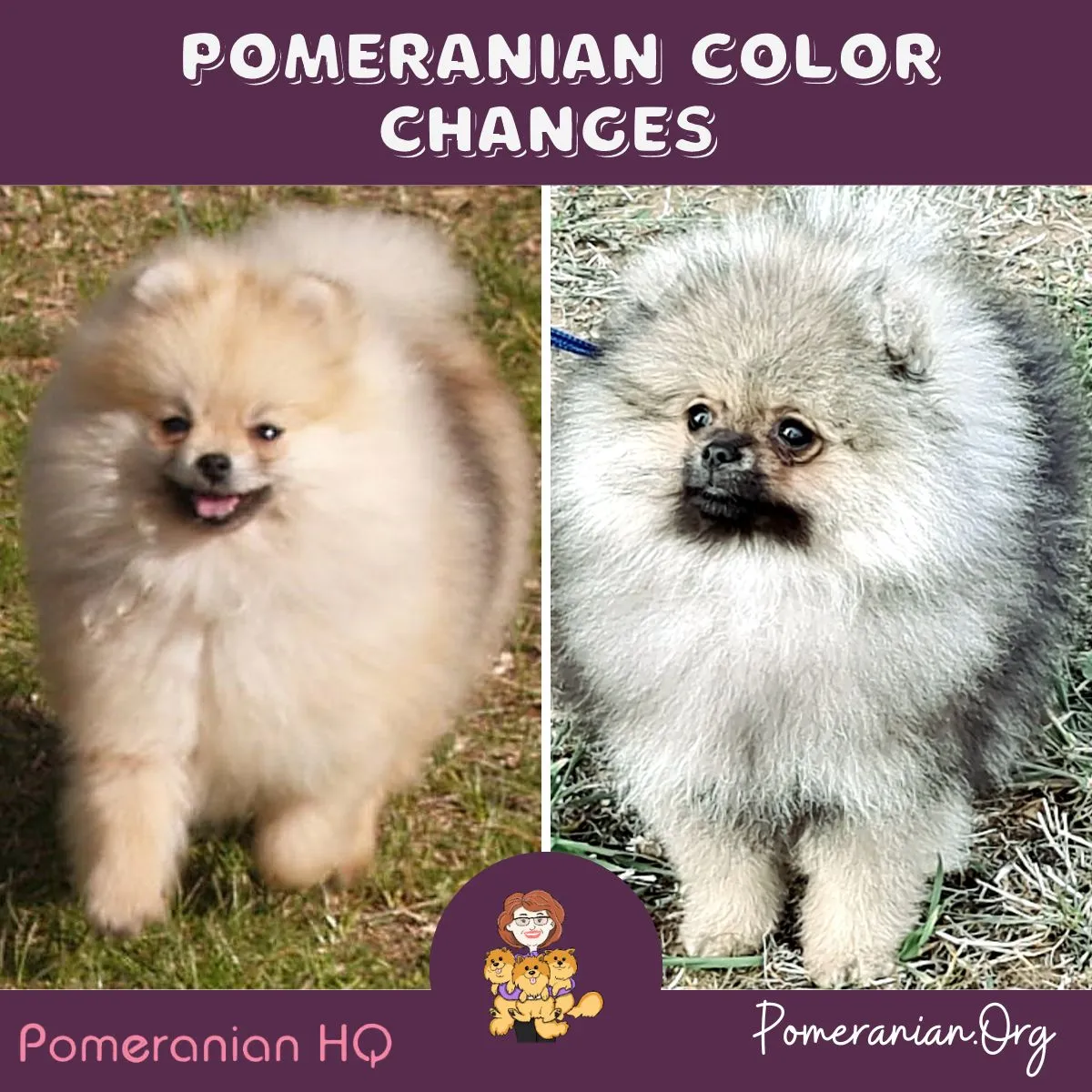 Pomeranian puppy transitioning to an adult Pomeranian with visible coat color changesPomeranian Puppy Color Changes – This image captures a Pomeranian puppy showing early signs of coat development, hinting at the vibrant color it will become as an adult.
Pomeranian puppy transitioning to an adult Pomeranian with visible coat color changesPomeranian Puppy Color Changes – This image captures a Pomeranian puppy showing early signs of coat development, hinting at the vibrant color it will become as an adult.
Cream Pomeranian Color Evolution
Light-colored Pom puppies are often very pale at birth, gradually darkening as they mature. A classic example is a cream or light orange Pomeranian puppy, which may appear white as a newborn but matures into a rich cream or orange hue. What might be referred to as a white Pomeranian puppy frequently matures into an orange adult Pomeranian.
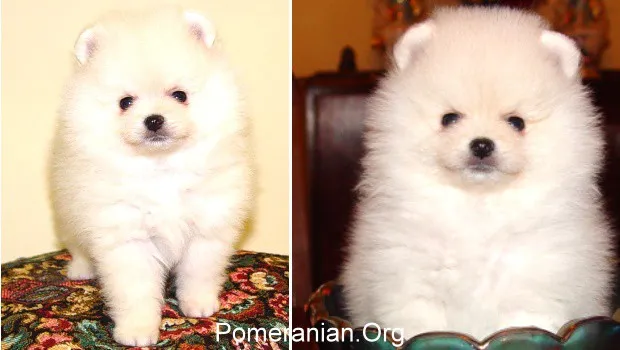 Eight-week-old cream Pomeranian puppies with soft, pale coatsCream Pomeranian Puppies – A group of fluffy 8-week-old cream Pomeranian puppies displaying their delicate, light-colored coats.
Eight-week-old cream Pomeranian puppies with soft, pale coatsCream Pomeranian Puppies – A group of fluffy 8-week-old cream Pomeranian puppies displaying their delicate, light-colored coats.
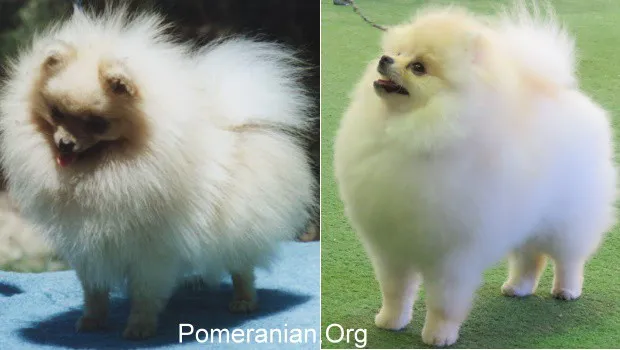 Adult cream Pomeranians showcasing their fully developed, rich coatsAdult Cream Pomeranians – Two fully grown cream Pomeranians, demonstrating the rich, deep cream tones of their mature adult coats.
Adult cream Pomeranians showcasing their fully developed, rich coatsAdult Cream Pomeranians – Two fully grown cream Pomeranians, demonstrating the rich, deep cream tones of their mature adult coats.
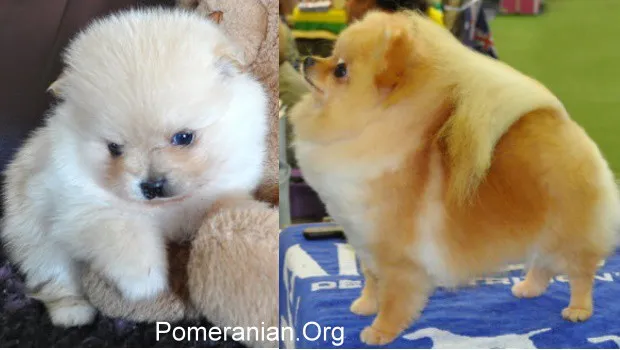 Orange Pomeranian from puppy to adult showing significant color deepeningOrange Pomeranian – This composite image shows an orange Pomeranian’s transformation: from a very light, almost white newborn puppy, to a cream-colored young Pom, and finally, a clear, vibrant orange as an adult Pomeranian.
Orange Pomeranian from puppy to adult showing significant color deepeningOrange Pomeranian – This composite image shows an orange Pomeranian’s transformation: from a very light, almost white newborn puppy, to a cream-colored young Pom, and finally, a clear, vibrant orange as an adult Pomeranian.
Black Pomeranians: Minimal Change, Deeper Hues
Generally, black Pomeranian puppies do not undergo dramatic color changes. However, their puppy fur may shed lighter shadings during the coat change, resulting in a deeper, more solid black appearance in the adult Pomeranian. Interestingly, Wolf Sable and Black and Tan Pomeranians can often appear completely black as newborns.
Sable Pomeranian Color Drama
The sable Pomeranian probably exhibits one of the most dramatic color changes from a baby Pomeranian to an adult Pomeranian. Sable puppies are typically born very dark, sometimes almost black. As their hair grows, the dark sable-colored tips extend to the end of the hair shaft, revealing the underlying base color, which can be orange, cream, or red.
Wolf Sable is another color that can be initially confusing. Beginner breeders sometimes mistakenly register an orange sable Pomeranian puppy as a Wolf Sable. Orange sable Pomeranian puppies might appear greyer than orange at six weeks, but the orange tones will develop as they mature. If in doubt about specific genetic colors, consulting your vet for a DNA test before registration is a wise step.
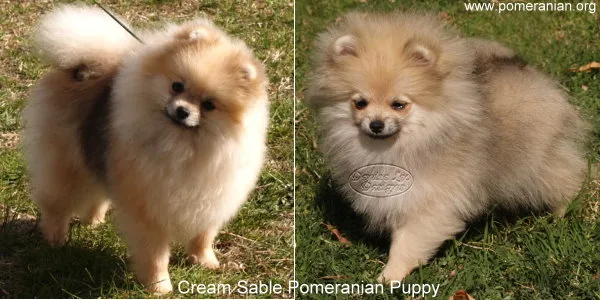 Cream Sable Pomeranian puppy showing initial dark markingsCream Sable Pomeranian Puppy – A young cream sable Pomeranian puppy, exhibiting the characteristic dark tipping over a cream base coat.
Cream Sable Pomeranian puppy showing initial dark markingsCream Sable Pomeranian Puppy – A young cream sable Pomeranian puppy, exhibiting the characteristic dark tipping over a cream base coat.
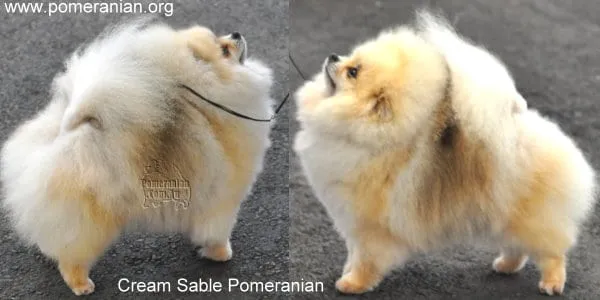 Champion Cream Sable Pomeranian adult with distinct sable markingsChampion Cream Sable Pomeranian Adult – A majestic champion adult Pomeranian with a fully developed cream sable coat, displaying clear, defined sable markings.
Champion Cream Sable Pomeranian adult with distinct sable markingsChampion Cream Sable Pomeranian Adult – A majestic champion adult Pomeranian with a fully developed cream sable coat, displaying clear, defined sable markings.
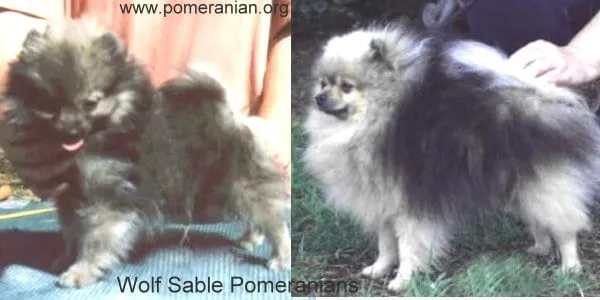 Wolf Sable Pomeranian puppy and a mature adult wolf sable PomeranianWolf Sable Puppy and Wolf Sable Pomeranian Adult – A side-by-side comparison showing a young Wolf Sable Pomeranian puppy next to a mature Wolf Sable adult Pomeranian, highlighting the development of their distinctive silver-grey and black-tipped fur.
Wolf Sable Pomeranian puppy and a mature adult wolf sable PomeranianWolf Sable Puppy and Wolf Sable Pomeranian Adult – A side-by-side comparison showing a young Wolf Sable Pomeranian puppy next to a mature Wolf Sable adult Pomeranian, highlighting the development of their distinctive silver-grey and black-tipped fur.
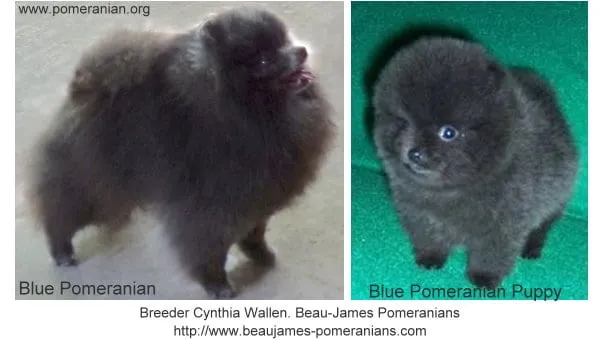 Blue Pomeranian adult and puppy side by sideBlue Pomeranians – A striking image of a blue Pomeranian puppy alongside an adult Pomeranian with a rich blue coat, bred by Beau James Pomeranians.
Blue Pomeranian adult and puppy side by sideBlue Pomeranians – A striking image of a blue Pomeranian puppy alongside an adult Pomeranian with a rich blue coat, bred by Beau James Pomeranians.
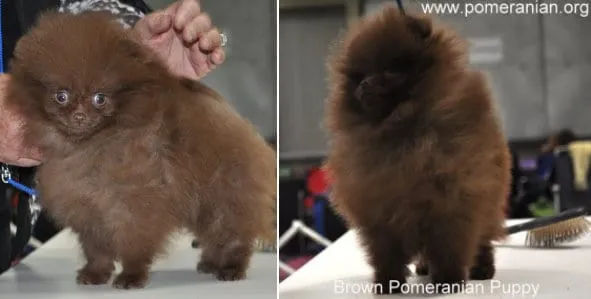 Chocolate Pomeranian puppy with soft brown furChocolate Brown Pomeranian Puppy – A cute chocolate brown Pomeranian puppy with its soft, developing fur.
Chocolate Pomeranian puppy with soft brown furChocolate Brown Pomeranian Puppy – A cute chocolate brown Pomeranian puppy with its soft, developing fur.
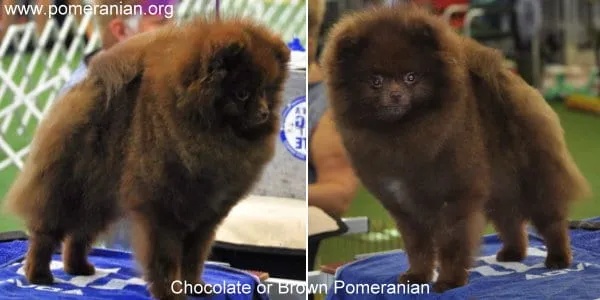 Adult chocolate Pomeranian with a deep, rich brown coatChocolate Pomeranian Adult – A stunning adult Pomeranian showcasing a deep, luxurious chocolate brown coat.
Adult chocolate Pomeranian with a deep, rich brown coatChocolate Pomeranian Adult – A stunning adult Pomeranian showcasing a deep, luxurious chocolate brown coat.
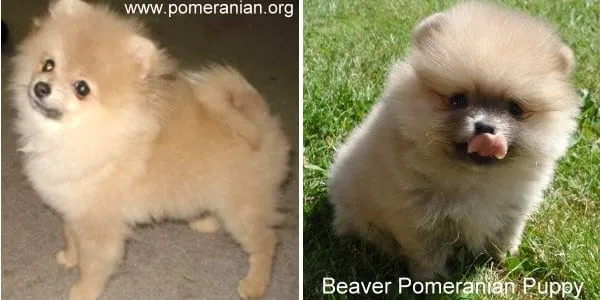 Beaver Pomeranian puppy displaying its unique dilute brown colorBeaver Pomeranian Puppy – An adorable beaver Pomeranian puppy, distinguished by its unique dilute brown coloration.
Beaver Pomeranian puppy displaying its unique dilute brown colorBeaver Pomeranian Puppy – An adorable beaver Pomeranian puppy, distinguished by its unique dilute brown coloration.
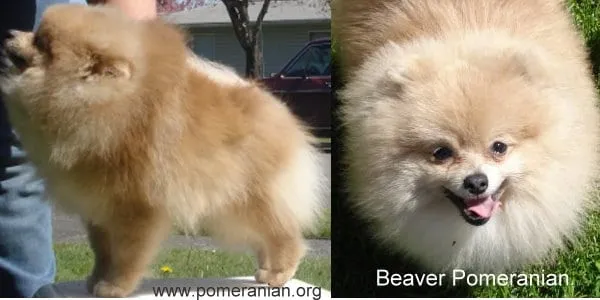 Adult beaver Pomeranian with a fully developed lighter brown coatBeaver Pomeranian Adult – A mature beaver adult Pomeranian, exhibiting the distinct lighter, grayish-brown hue of its adult coat.
Adult beaver Pomeranian with a fully developed lighter brown coatBeaver Pomeranian Adult – A mature beaver adult Pomeranian, exhibiting the distinct lighter, grayish-brown hue of its adult coat.
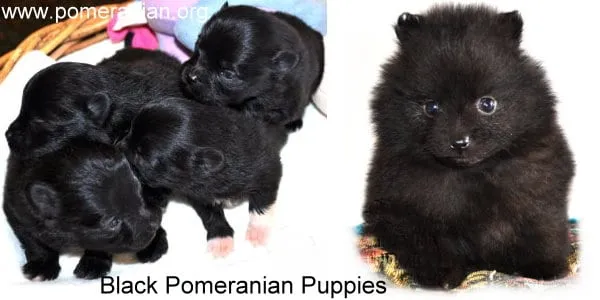 Group of black Pomeranian puppies playing togetherBlack Pomeranian Puppies – A charming photograph of several black Pomeranian puppies, showcasing their sleek, dark coats.
Group of black Pomeranian puppies playing togetherBlack Pomeranian Puppies – A charming photograph of several black Pomeranian puppies, showcasing their sleek, dark coats.
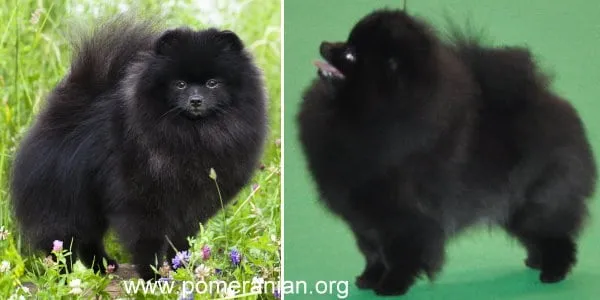 Pictures of black Pomeranians in various posesPictures of Black Pomeranians – A collection of images featuring magnificent black adult Pomeranians, illustrating the depth and shine of their fully developed coats.
Pictures of black Pomeranians in various posesPictures of Black Pomeranians – A collection of images featuring magnificent black adult Pomeranians, illustrating the depth and shine of their fully developed coats.
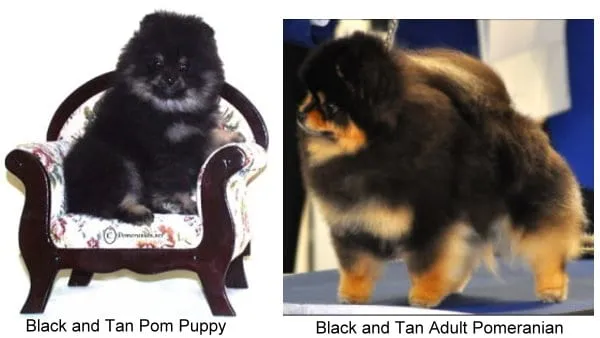 Black and Tan Pomeranian puppy and a mature black and tan adultBlack and Tan Pomeranian Puppy and Black and Tan Pomeranian Adult – A visual comparison of a Black and Tan Pomeranian as a puppy, where the tan markings are typically lighter, and as an adult Pomeranian, where the tan usually darkens with maturity.
Black and Tan Pomeranian puppy and a mature black and tan adultBlack and Tan Pomeranian Puppy and Black and Tan Pomeranian Adult – A visual comparison of a Black and Tan Pomeranian as a puppy, where the tan markings are typically lighter, and as an adult Pomeranian, where the tan usually darkens with maturity.
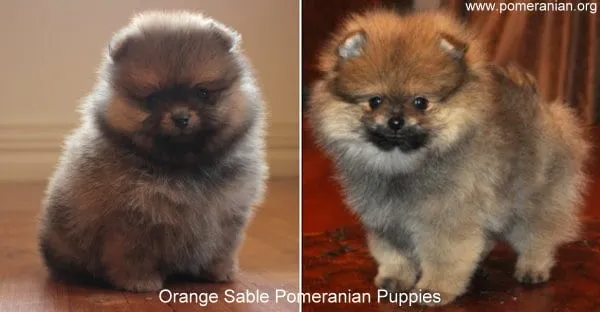 Orange Sable Pomeranian puppies with initial greyish tonesOrange Sable Pomeranian Puppies – A litter of playful orange sable Pomeranian puppies, displaying their characteristic greyish undertones and dark sable tipping.
Orange Sable Pomeranian puppies with initial greyish tonesOrange Sable Pomeranian Puppies – A litter of playful orange sable Pomeranian puppies, displaying their characteristic greyish undertones and dark sable tipping.
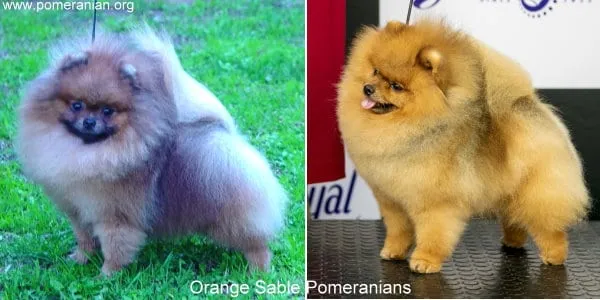 Orange Sable Pomeranian adults with vibrant orange and sable markingsOrange Sable Pomeranian Adults – Beautiful orange sable adult Pomeranians, showcasing their vibrant orange base coats and prominent sable markings.
Orange Sable Pomeranian adults with vibrant orange and sable markingsOrange Sable Pomeranian Adults – Beautiful orange sable adult Pomeranians, showcasing their vibrant orange base coats and prominent sable markings.
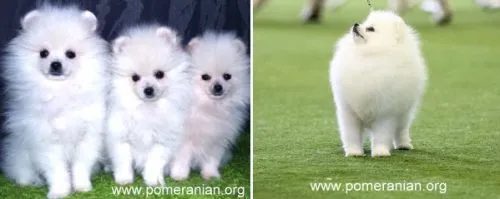 Brindle Pomeranian puppy with developing striped patternWhite Pomeranian Puppies – A delightful image of fluffy white Pomeranian puppies, highlighting their pristine, snowy coats. Though these are white, Brindle Pomeranians exhibit unique striped patterns as they mature, seen in dogs like Beau James Stripe Up The Band by breeder Cynthia Wallen.
Brindle Pomeranian puppy with developing striped patternWhite Pomeranian Puppies – A delightful image of fluffy white Pomeranian puppies, highlighting their pristine, snowy coats. Though these are white, Brindle Pomeranians exhibit unique striped patterns as they mature, seen in dogs like Beau James Stripe Up The Band by breeder Cynthia Wallen.
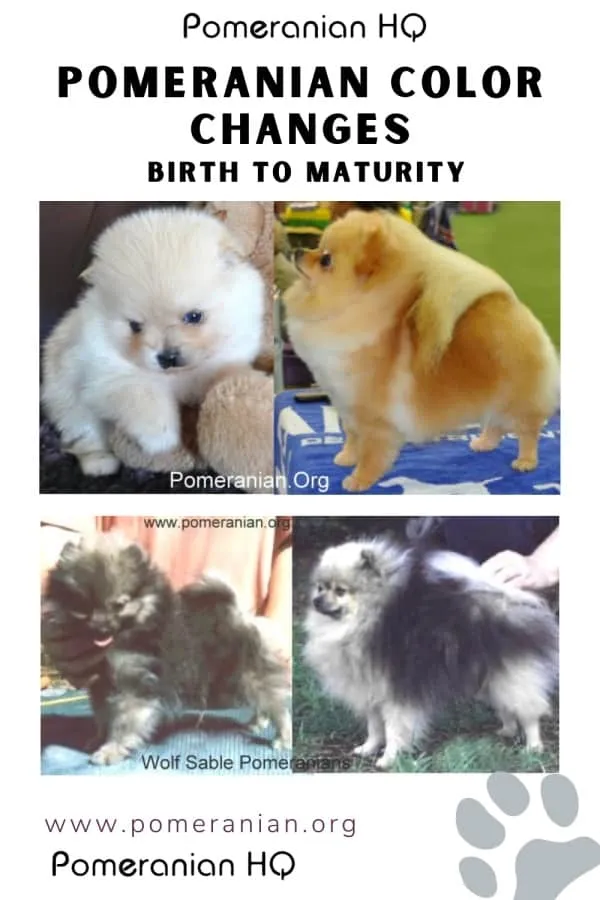 Pomeranian puppy displaying its coat during various stages of color changePomeranian Puppy Color Changes – An illustrative image depicting the gradual and fascinating coat color changes a Pomeranian undergoes from puppyhood into its adult stage.
Pomeranian puppy displaying its coat during various stages of color changePomeranian Puppy Color Changes – An illustrative image depicting the gradual and fascinating coat color changes a Pomeranian undergoes from puppyhood into its adult stage.
Understanding what makes a complete and balanced diet is essential for maintaining a healthy coat and overall vitality, whether you’re feeding a growing puppy or an adult Pomeranian. For insights into specific dietary needs, you might consult resources on topics like best wet dog food for senior dogs as they age. Similarly, knowing what human food can Pomeranians eat can help ensure you’re providing safe and healthy treats.
Key Takeaways on Pomeranian Coat Color Changes
The journey of a Pomeranian’s coat color is a beautiful and natural aspect of their growth, offering a unique display for every owner.
- Natural Phenomenon: The transformation of a Pomeranian’s coat color is an inherent part of their development, moving from the soft, often subtle hues of puppyhood to the vibrant, defined shades of an adult Pomeranian.
- Unique to Each Dog: Every Pomeranian is an individual, and their coat transformation will be unique. While some may undergo dramatic shifts, others might retain a similar shade with subtle enhancements in depth and richness.
- Diverse Color Palette: Pomeranians are renowned for their incredible variety of coat colors, ranging from the striking clarity of blacks and whites to the rarer and enchanting blues, chocolates, sables, and brindles.
- Patience for Full Maturity: The complete color change does not happen overnight. It is a gradual process that unfolds as your Pom matures, typically settling into their final adult coat by 12-18 months. Patience is essential to fully appreciate this delightful progression.
- Prioritizing Health Over Aesthetics: While the diverse colors of Pomeranian coats are adored, it’s paramount to prioritize their health and well-being above purely aesthetic considerations. A healthy Pom, with proper nutrition and care, will always boast the most beautiful and vibrant coat, regardless of its specific shade.
While a definitive, universal Pomeranian color change chart is challenging to create due to individual variations, the photographic examples provided offer a comprehensive guide to understanding your pup’s unique color evolution.
Copyright DogCareStory.com. All Rights Reserved.
References and Further Reading:
- Official Standard of the Pomeranian (AKC). American Kennel Club, 2011.
- Official English Kennel Club Pomeranian Breed Standard, 2017.
- Denise Leo, The Pomeranian Handbook.
